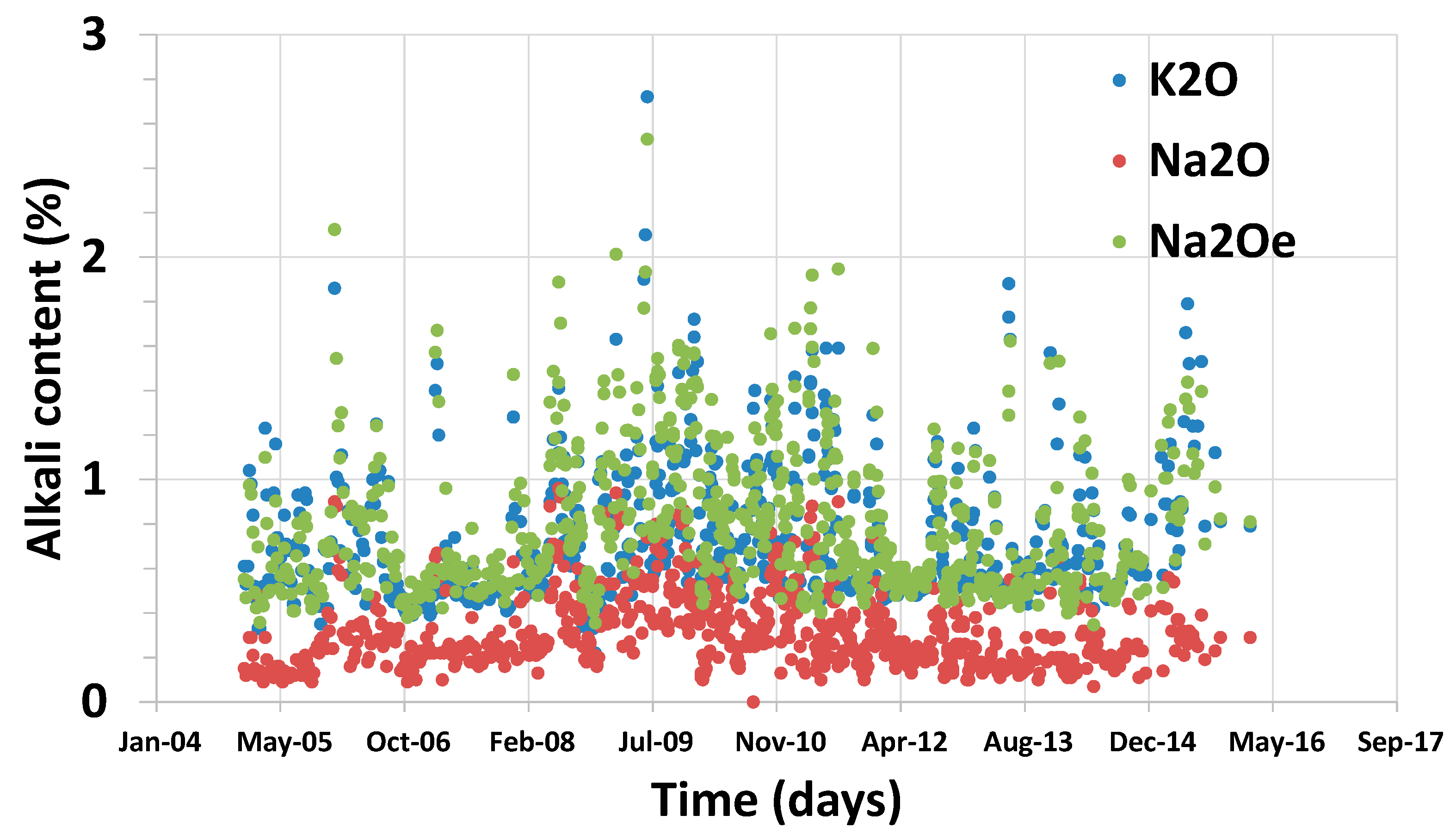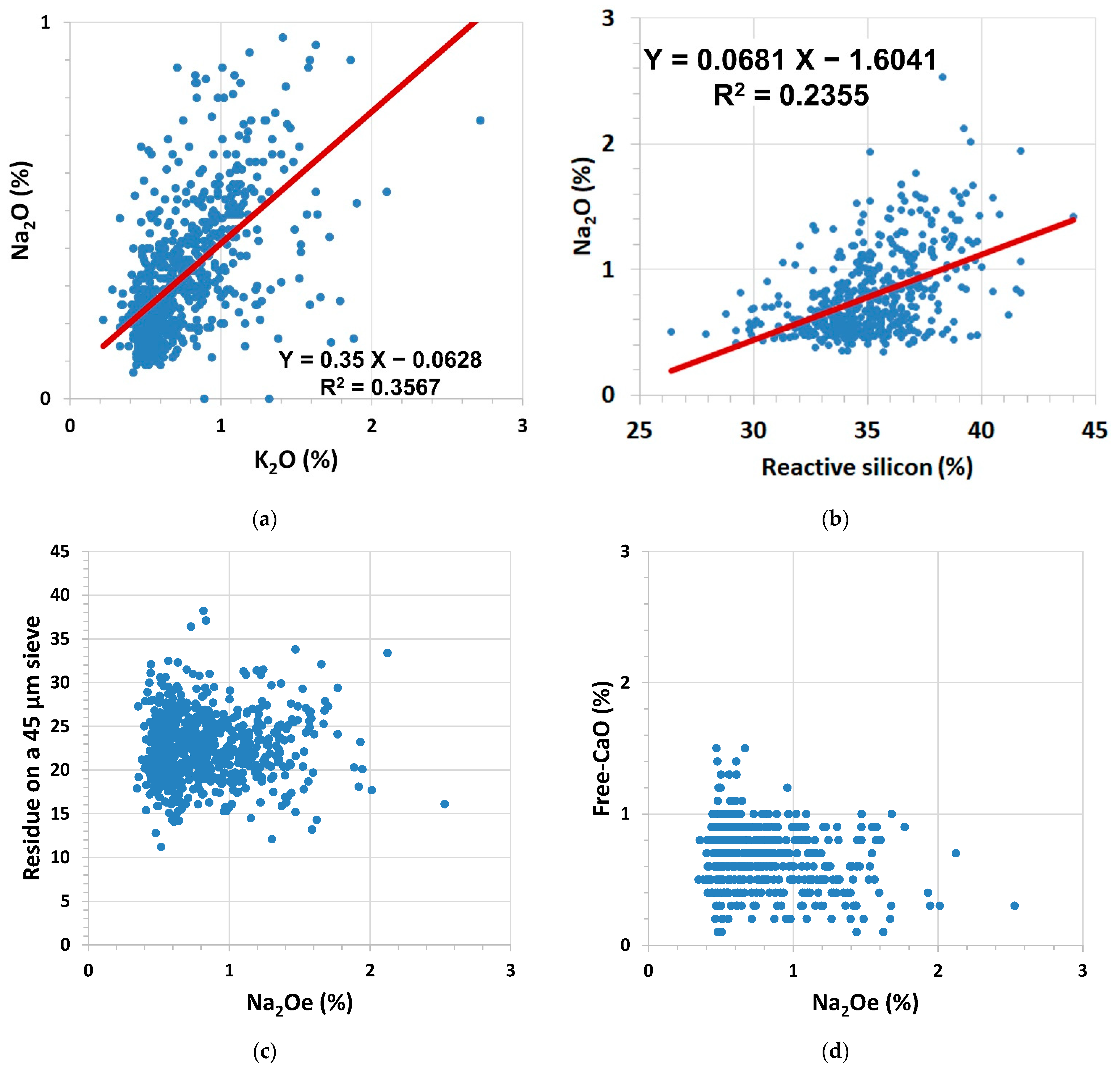A Ten-Year Study on Alkali Content of Coal Fly Ash
Abstract
:1. Introduction
- Restricting the concrete pore solution alkalinity by utilizing blended cements containing active mineral additions such as coal fly ash. They must meet a well-defined limit of alkali content;
- Constraining the ASR gel expansion by modifying the gel nature by using lithium-containing products;
- The use of low-alkali cements, i.e., Na2Oe = Na2O + 0.658 K2O < 0.6%.
2. Materials and Methods
2.1. Coal Fly Ash Sampling
2.2. Alkali Content, Reactive Silica, Free-CaO, and Fineness Determination
2.3. Coal Fly Ash Chemical Analyses
3. Results and Discussion
3.1. Alkali Content over the Years
3.2. The Na2O-Equivalent Relationships
3.3. Reactive Silicon versus 45 µm Residue Relationship
4. Conclusions
- The Na2O-equivalent of coal fly ash ranged from 0.35% to 2.53%, with an average value of 0.79%. These values should be taken into account producing concretes made with potentially reactive aggregates in order to mitigate the alkali–silica reaction (ASR);
- There is a positive correlation between Na2O and K2O of coal fly ash and there is only a weak relationship between the Na2O-equivalent and reactive silica. Therefore, the mathematical relationship between the two variables is such that knowledge of one key cannot be used to deduce the other;
- Conversely, this study confirms no correlation between the reactive silicon and the 45 µm residue. In addition, non-correlation between the Na2O-equivalent content and the 45 µm residue or the free lime in coal fly ash were found;
- The most significant performance characteristics of coal fly ash in concrete are the particle size (percentage retained on a 45 µm sieve), reactive silica content and the Na2O-equivalent amount. They should be determined independently since a weak or non-correlation was found between them.
Author Contributions
Funding
Institutional Review Board Statement
Informed Consent Statement
Data Availability Statement
Acknowledgments
Conflicts of Interest
References
- IEA. Coal-Fired Power, IEA, Paris. 2021. Available online: https://www.iea.org/reports/coal-fired-power (accessed on 19 April 2022).
- Argiz, C.; Menéndez, E.; Moragues, A.; Sanjuán, M.A. Fly ash characteristics of Spanish coal-fired power plants. Afinidad 2015, 72, 269–277. Available online: http://www.raco.cat/index.php/afinidad/article/viewFile/305569/395407 (accessed on 19 April 2022).
- European Commission. A New Circular Economy Action Plan. For a Cleaner and More Competitive Europe. In Proceedings of the Communication from the Commission to the European Parliament, The Council, the European Economic and Social Committee and the Committee of the Regions. COM(2020) 98 Final, Brussels, Belgium. 2020. Available online: https://eur-lex.europa.eu/resource.html?uri=cellar:9903b325-6388-11ea-b735-01aa75ed71a1.0017.02/DOC_1&format=PDF (accessed on 19 April 2022).
- Sanjuán, M.A.; Argiz, C.; Mora, P.; Zaragoza, A. Carbon Dioxide Uptake in the Roadmap 2050 of the Spanish Cement Industry. Energies 2020, 13, 3452. [Google Scholar] [CrossRef]
- Taylor, H.F.W. Cement Chemistry, 2nd ed.; Thomas Telford: London, UK, 1997. [Google Scholar]
- EN 197−1:2011; Cement—Part 1: Composition, Specifications and Conformity Criteria for Common Cement. European Committee for Standardization (CEN): Brussels, Belgium, 2011.
- Argiz, C.; Sanjuán, M.A.; Menéndez, E. Coal Bottom Ash for Portland Cement Production. Adv. Mater. Sci. Eng. 2017, 2017, 1–7. [Google Scholar] [CrossRef] [Green Version]
- Blissett, R.; Rowson, N. A review of the multi-component utilization of coal fly ash. Fuel 2012, 97, 1–23. [Google Scholar] [CrossRef]
- Ahmaruzzaman, M. A review on the utilization of fly ash. Prog. Energy Combust. Sci. 2010, 36, 327–363. [Google Scholar] [CrossRef]
- Sánchez de Rojas, M.I.; Frías, M. The pozzolanic activity of different materials, its influence on the hydration heat in mortars. Cem. Concr. Res. 1996, 26, 203–213. [Google Scholar] [CrossRef]
- Tremblay, C.; Bérubé, M.-A.; Fournier, B.; Thomas, M.D.; Folliard, K.J. Experimental investigation of the mechanisms by which LiNO3 is effective against ASR. Cem. Concr. Res. 2010, 40, 583–597. [Google Scholar] [CrossRef]
- Moazzem, S.; Rasul, M.G.; Khan, M.M.K. A Review on Technologies for Reducing CO2 Emission from Coal Fired Power Plants. In Thermal Power Plants, 1st ed.; Rasul, M., Ed.; IntechOpen Limited: London, UK, 2012; Volume 1, pp. 227–254. [Google Scholar] [CrossRef] [Green Version]
- EN 196-2; Method of Testing Cement—Part 2: Chemical Analysis of Cement. European Committee for Standardization (CEN): Brussels, Belgium, 2013.
- UNE 80225:2012; Methods of Testing Cement. Chemical Analysis. Determination of Reactive SiO2 Content in Cements, Puzzolans and Fly Ash. Spanish Standards Institution (AENOR): Madrid, Spain, 2012.
- UNE 80243:2002; Cement Test Methods. Chemical Analysis. Determination of Free Calcium Oxyde. Ethylenglycol Method. Spanish Standards Institution (AENOR): Madrid, Spain, 2002.
- EN 196-6; Methods of Testing Cement—Part 6: Determination of Fineness. European Committee for Standardization (CEN): Brussels, Belgium, 2010.
- EN 450-1; Fly Ash for Concrete: Definitions, Requirements and Quality Control. European Committee for Standardization (CEN): Brussels, Belgium, 2012.
- Menéndez, E.; Sanjuán, M.Á.; García-Roves, R.; Argiz, C.; Recino, H. Durability of Blended Cements Made with Reactive Aggregates. Materials 2021, 14, 2948. [Google Scholar] [CrossRef]
- Menéndez, E.; Sanjuán, M.Á.; García-Roves, R.; Argiz, C.; Recino, H. Sustainable and Durable Performance of Pozzolanic Additions to Prevent Alkali-Silica Reaction (ASR) Promoted by Aggregates with Different Reaction Rates. Appl. Sci. 2020, 10, 9042. [Google Scholar] [CrossRef]
- Sanjuán, M.A.; Argiz, C. Coal fly ash alkalis content characterization by means of a full factorial design. Mater. Lett. 2016, 164, 528–531. [Google Scholar] [CrossRef]
- Itskos, G.; Itskos, S.; Moutsatsou, A.; Vasilatos, C.; Koukouzas, N.; Kakaras, E. The Outcomes of the 2-Decade Monthly Monitoring of Fly Ash-Composition in a Lignite-Fired Power Station. Waste Biomass Valor. 2010, 1, 431–437. [Google Scholar] [CrossRef]
- Huang, L.; Yan, P. Effect of alkali content in cement on its hydration kinetics and mechanical properties. Constr. Build. Mater. 2019, 228, 116833. [Google Scholar] [CrossRef]
- Kumar, A.; Sant, G.; Patapy, C.; Gianocca, C.; Scrivener, K. The influence of sodium and potassium hydroxide on alite hydration: Experiments and simulations. Cem. Concr. Res. 2012, 42, 1513–1523. [Google Scholar] [CrossRef]
- Ma, Y.; Qian, J. Influence of alkali sulfates in clinker on the hydration and hardening of Portland cement. Constr. Build. Mater. 2018, 180, 351–363. [Google Scholar] [CrossRef]
- Snellings, R.; Salze, A.; Scrivener, K. Use of X-ray diffraction to quantify amorphous supplementary cementitious materials in anhydrous and hydrated blended cements. Cem. Concr. Res. 2014, 64, 89–98. [Google Scholar] [CrossRef]
- Sant, G.; Kumar, A.; Patapy, C.; Saout, G.; Scrivener, K. The influence of sodium and potassium hydroxide on volume changes in cementitious materials. Cem. Concr. Res. 2012, 42, 1447–1455. [Google Scholar] [CrossRef]
- Mota, B.; Matschei, T.; Scrivener, K. Impact of NaOH and Na2SO4 on the kinetics and microstructural development of white cement hydration. Cem. Concr. Res. 2018, 108, 172–185. [Google Scholar] [CrossRef]
- Sanjuán, M.Á.; Argiz, C. Fineness of Coal Fly Ash for Use in Cement and Concrete. Fuels 2021, 2, 471–486. [Google Scholar] [CrossRef]
- Aydın, S.; Karatay, Ç.; Baradan, B. The effect of grinding process on mechanical properties and alkali–silica reaction resistance of fly ash incorporated cement mortars. Powder Technol. 2010, 197, 68–72. [Google Scholar] [CrossRef]
- Payá, J.; Monzó, J.; Borrachero, M.; Peris-Mora, E.; Amahjour, F. Mechanical treatment of fly ashes: Part IV. Strength development of ground fly ash-cement mortars cured at different temperatures. Cem. Concr. Res. 2000, 30, 543–551. [Google Scholar] [CrossRef]
- Sanjuán, M.; Argiz, C.; Galvez, J.; Moragues, A. Effect of silica fume fineness on the improvement of Portland cement strength performance. Constr. Build. Mater. 2015, 96, 55–64. [Google Scholar] [CrossRef]
- Sharma, R.C.; Jain, N.K.; Ghosh, S.N. Semi-theoretical method for the assessment of reactivity of fly ashes. Cem. Concr. Res. 1993, 23, 41–45. [Google Scholar] [CrossRef]
- Antiohos, S.K.; Tsimas, S. Reactive silica of fly ash as an indicator for the mechanical performance of blended cements. In Measuring, Monitoring and Modeling Concrete Properties, 1st ed.; Konsta-Gdoutos, M.S., Ed.; Springer: Dordrecht, The Netherlands, 2006; Volume 1, pp. 403–409. [Google Scholar] [CrossRef]




| Alkali | Europe | USA | China | India | Australia | Bituminous | Sub-Bituminous | Lignite |
|---|---|---|---|---|---|---|---|---|
| Na2O | 0.1–1.9 | 0.3–1.8 | 0.6–1.3 | 0.5–1.2 | 0.2–1.3 | 0–4 | 0–2 | 0–6 |
| K2O | 0.4–4 | 0.9–2.6 | 0.8–0.9 | 0.8–4.7 | 1.1–2.9 | 0–3 | 0–4 | 0–4 |
| Ultimate Analyses | Analyses Method | Not Dried | Dried with Air | Dry Basis |
|---|---|---|---|---|
| Moisture (%) | ASTM D 5142:2004 | 4.97 | 2.15 | - |
| Carbon (%) | ASTM D 5373:2008 | 67.21 | 69.20 | 70.72 |
| Hydrogen (excluido el H de la humedad) (%) | ASTM D 5373:2008 | 3.62 | 3.73 | 3.81 |
| Nitrogen (%) | ASTM D 5373:2008 | 1.54 | 1.59 | 1.62 |
| Total sulphur (%) | ASTM D 4239:B:2005 | 0.35 | 0.36 | 0.37 |
| Ash content (%) | ISO 1171:1997 | 14.97 | 15.41 | 15.75 |
| Volatile matter (%) | ISO 562:1998 | 23.38 | 24.07 | 24.06 |
| The percentage of oxygen is found by difference (excluding moisture oxygen from the analysis) (%) | 7.34 | 7.56 | 7.73 | |
| Gross calorific value (kcal/kg) | ISO 1928:2009:E | 6265 | 6451 | 6593 |
| Hard grove grindability index (HGI) with a moisture content of (%) | ISO 5074:1994 | 54 1.41 | - | - |
| CO2 emission factor (Directive 2003/87/EC) (tCO2/TJ) | 97.0 |
| Equipment/General | Part | Group 1 | Group 2 |
|---|---|---|---|
| General | Power | 576.9 | 582 |
| Year | 1985 | 1997 | |
| Boiler | Type | Combustion in tangential swirl burners | Combustion in tangential swirl burners |
| Producer | Combustion Engineering | ABB | |
| Coal burners | 24 | 24 | |
| Main steam flow-rate | 1679 t/h | 1679 t/h | |
| Superheated steam flow-rate | 1525 t/h | 1525 t/h | |
| Initial steam pressure | 176 bar | 176 bar | |
| Superheated steam pressure | 41 bar | 41 bar | |
| Feedwater temperature | 253 °C | 253 °C | |
| Main steam inlet temperature | 541 °C | 541 °C | |
| Energy yield of the steam boiler | 89.42% | 89.42% | |
| Condenser | Type | Dual-pressure condenser | Dual-pressure condenser |
| Cooling fluid | Seawater in an open circuit cooling system | Seawater in an open circuit cooling system | |
| Condenser water flow rate | 60.408 m3/h | 60.408 m3/h | |
| Turbine | Manufacturer | Bazán/G.E.E. | data |
| Maximum power | 577 MW | 577 MW | |
| Number of bodies | 4 | 4 | |
| Number of removals | 7 | 7 | |
| Operating speed | 3000 rpm | 3000 rpm | |
| Alternator | Manufacturer | General Electric | General Electric |
| Power | 636 MVA | 636 MVA. | |
| Transformer | Manufacturer | Westinghouse. | Westinghouse. |
| Power | 209.5 MVA | 209.5 MVA |
| Technology | CO2 Emissions (Kg/MWh) |
|---|---|
| Pulverised coal-fired subcritical | 850 |
| PC-fired supercritical | 800 |
| 670 |
| Parameter | SiO2 | Al2O3 | Fe2O3 | CaO | MgO | SO3 | K2O | Ti2O5 | P2O5 | LOI | IR 1 | Cl− |
|---|---|---|---|---|---|---|---|---|---|---|---|---|
| Content (%) | 50.5 | 28.9 | 4.7 | 5.0 | 1.8 | 0.21 | 0.8 | 1.56 | 0.76 | 3.6 | 71.3 | 0.001 |
Publisher’s Note: MDPI stays neutral with regard to jurisdictional claims in published maps and institutional affiliations. |
© 2022 by the authors. Licensee MDPI, Basel, Switzerland. This article is an open access article distributed under the terms and conditions of the Creative Commons Attribution (CC BY) license (https://creativecommons.org/licenses/by/4.0/).
Share and Cite
Sanjuán, M.Á.; Argiz, C. A Ten-Year Study on Alkali Content of Coal Fly Ash. Fuels 2022, 3, 365-374. https://doi.org/10.3390/fuels3020023
Sanjuán MÁ, Argiz C. A Ten-Year Study on Alkali Content of Coal Fly Ash. Fuels. 2022; 3(2):365-374. https://doi.org/10.3390/fuels3020023
Chicago/Turabian StyleSanjuán, Miguel Ángel, and Cristina Argiz. 2022. "A Ten-Year Study on Alkali Content of Coal Fly Ash" Fuels 3, no. 2: 365-374. https://doi.org/10.3390/fuels3020023





